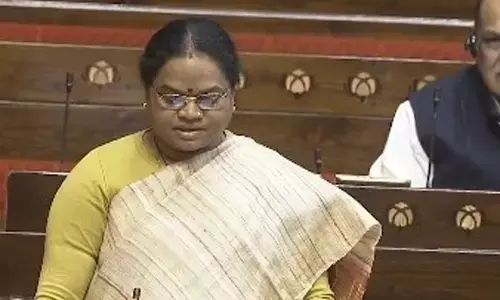A technical issue mired in controversy

The controversy about the back series of the Gross Domestic Product GDP of the country is really most unfortunate The time chosen, the method adopted, and the governments postevent response create the clear impression that a technical issue has acquired political colour A highly avoidable situation, to say the least
The controversy about the back series of the Gross Domestic Product (GDP) of the country is really most unfortunate. The time chosen, the method adopted, and the government’s post-event response create the clear impression that a technical issue has acquired political colour. A highly avoidable situation, to say the least!
We must, at the very outset, accept that there is an inbuilt element of the magical in the very nature of the discipline of Statistics. It can hardly be gainsaid that it has often been used as a willing handmaiden of those who can handle it with skill and practically any desired conclusion can be drawn from a given set of data. Always provided, of course, that one is willing not to be too squeamish about adopting slightly questionable approaches.
Take two high schools, one claiming 100 percent success in exams may having only one student, and another one claiming 95 percent, having a hundred students, it is the second school which had a better result although, at first sight, one might form the opposite impression. Does this mean that the first was lying? No. As Edmund Burke put it aptly, it was just being “economical with the truth!” So, it is with governments that, sometimes, absolute figures are given and, at others, percentages, depending on the spin sought to be imparted.
To evaluate the performance of a State in India, for example, one should be clear about the index being applied. A State may do well in terms of economic growth, while faring poorly in parameters that make up the Human Development Index (HDI). Similarly, a country’s GDP growth might be spectacular, but it may be denying human rights and freedom to the press. The subject makes all the difference.
The Ministry of Statistics and Programme Implementation (MoSPI) has, for a long time now, been following certain basic principles in order to measure the GDP. 2004-05 was the base year for earlier calculations and, in 2005, was changed to the year 2011-12, without clarifying specific reason was for selecting that year. And, at the same time, that Ministry adopted the concept of Gross Value Added (GVA) as a better measure to estimate economic activity. Having done that, it would have been alright if they had only used that method in respect of the succeeding years. But they extended the logic to the previous years also, in order to be able to claim that GDP growth was less in UPA regime than in NDA regime.
The question that naturally arises is, what warranted this? The data released on 31-08-2018 showed that, in the first quarter (April-June) of that year, GDP grew by 8.2 percent over the corresponding period of the previous year. On the other hand, the latest (30-11-2018) data showed that in the second quarter (July – September) the growth of GDP was only 7.1 percent. Apparently disturbed by this revelation, the ruling party chose to release latest reassessment of UPA regime. The latest figures showed that the average growth rate during the ten-year regime of the UPA was 6.7 percent (as per old methodology it was 8.1 percent in UPA-I and 7.46 percent in UPA-II) while the growth rate in the first four years of the NDA regime worked out to be 7.35 percent. The new methodology was able to show that the Indian economy never actually graduated to a “high growth” phase of more than 9 percent in the last decade or so.
Why the numbers have changed as they did is a technical issue. It is, however, understood that, while conducting the exercise, the present government adopted the National Accounts System endorsed by the United Nations, which included the GVA, the Net Value Added (NVA), and the use of new data sources wherever available. So far so good. The complication arose when this exercise was mixed up with the information being put out by the Ministry of Company Affairs (MCA) through what is called MCA-21.
The specialty of the MCA-21 method is that its database allows for a more granular approach, looking at the balance sheet data of each company and aggregating in the performance of the sector from that, after adjusting for inflation. And the old method measured volumes – actual physical output in the manufacturing sector, crop production and employment for the services sector. The problem is that MCA-21 is available only from 2011-12. Therefore, one is unable to fathom how the government could work out back series GDP data without matching data for the older series.
The question that arises is the extent to which MCA-21 database can be regarded as standard and the acceptability of the methods adopted by the Ministry. Had the numbers come out of the Central Statistical Organisation, which is the appropriate authority for the purpose, they would certainly have had more credibility. The fact that they have been released by the Niti Aayog casts a shadow on their reliability. The same point was also made by Pranab Sen, formerly the Chief Statistician of India. One is constrained to point out that the government would have done well to have avoided this questionable step.
The timing of the release of the numbers is also somewhat inconvenient. There is a countrywide discussion going on today about the failure of the demonetisation programme, two years down the road. Many experts including Arvind Subramanian (who was the Chief Economic Adviser at that time), now accept that the demonetisation measure certainly slowed down the national economy. Thus, one cannot help suspecting that the timing of the release of the data under discussion was planned by the government to protect its image which had suffered on account of earlier failures, and to show that nothing great happened even under the UPA regime.
Arun Jaitley’s statements following the release of the fresh statistics only served to strengthen that feeling. The National Statistical Commission (NSC) constituted a Committee under chairmanship of Dr Sudipto Mundle, whose report on Real Sector Statistics was released in August 2018. It had worked out a back series for economic growth from 1994-95 using the new methodology and showed that growth in 2006-07 actually touched 10.08 percent, against 9.57 percent when calculated under the old methodology. Within three months the situation had changed. It is intriguing how the same tool delivered two different results!
As was noted at the beginning of this piece, what matters is which elements of a given set of data are taken into account while drawing conclusions from its analysis. If, for instance, weightage was given to the number of temples built under a Mughal Emperor’s clearly Akbar would not merit to be called ‘Akbar the great’! On the other hand, if innovative ideas were the touchstone to judge greatness, Tughlak would rate as the best since he introduced leather coins and shifted the capital.
It would not be wise to attempt to comment on the MCA-21 database unless one is sure about the factors which were taken into consideration during that exercise. It is even possible that the new method has some positive features. But, as already noted, the attempt to make it apply to the past, the timing of the release, the method of making it public, and the political slant of the comments made thereafter by those representing the establishment, have all contributed to colouring the light in which they are now being looked at.
There are those who are asking why, if it was true that the GDP grew so rapidly during the NDA regime, a correspondingly high degree of employment generation is not obtaining: why the banking structure has weakened, why the growth rate of the leading private sector companies has fallen, why the overall investment has declined by 5-6 percent, and the credit growth rate of industries is a mere 1.4 percent. The whole exercise reminds one of the Wodehousian character who caught himself cheating at Solitaire. When all has been said and done, it would appear that wisdom lies in leaving technical matters to experts. In other words, do not venture where angels fear to tread!

















